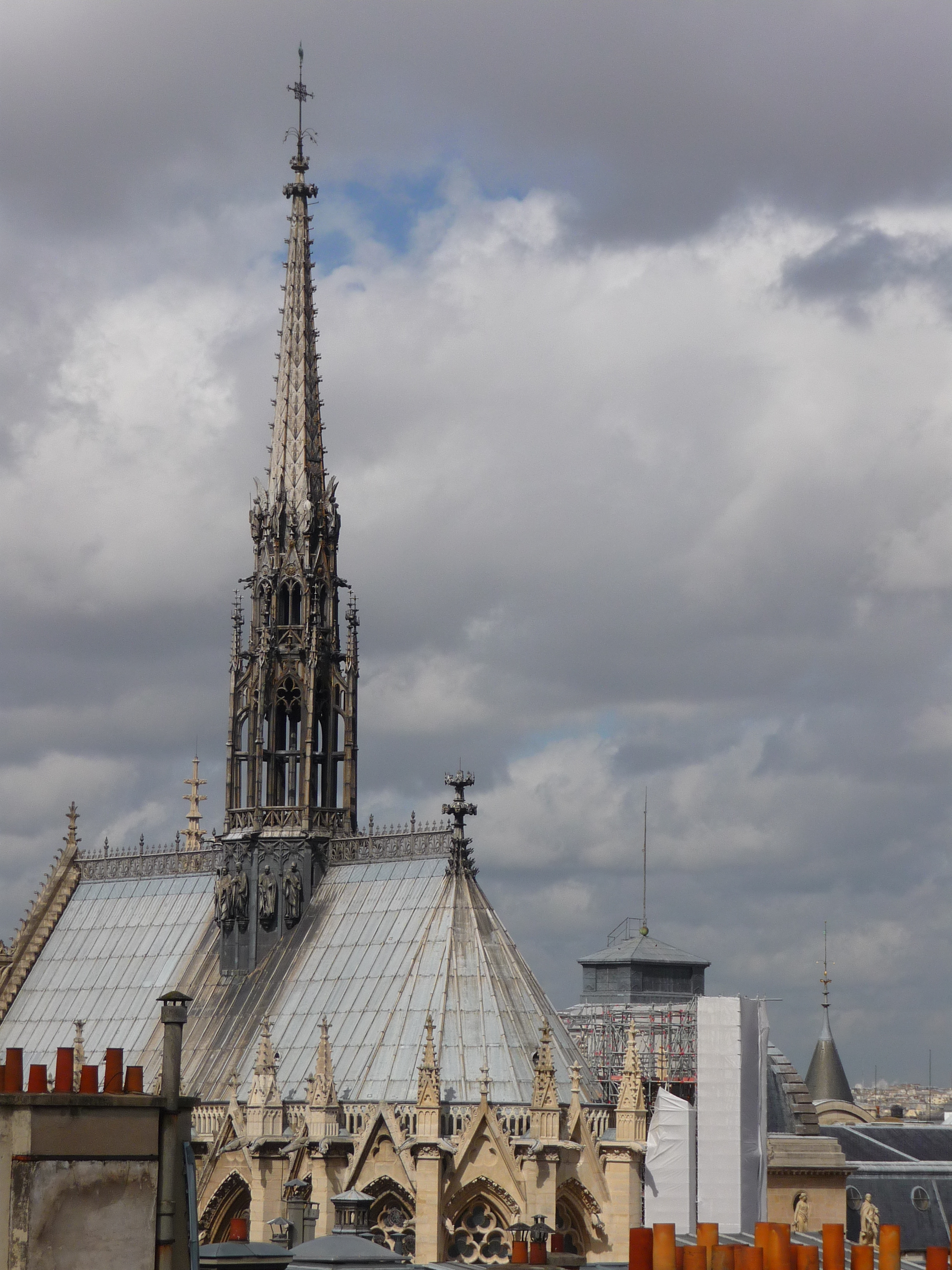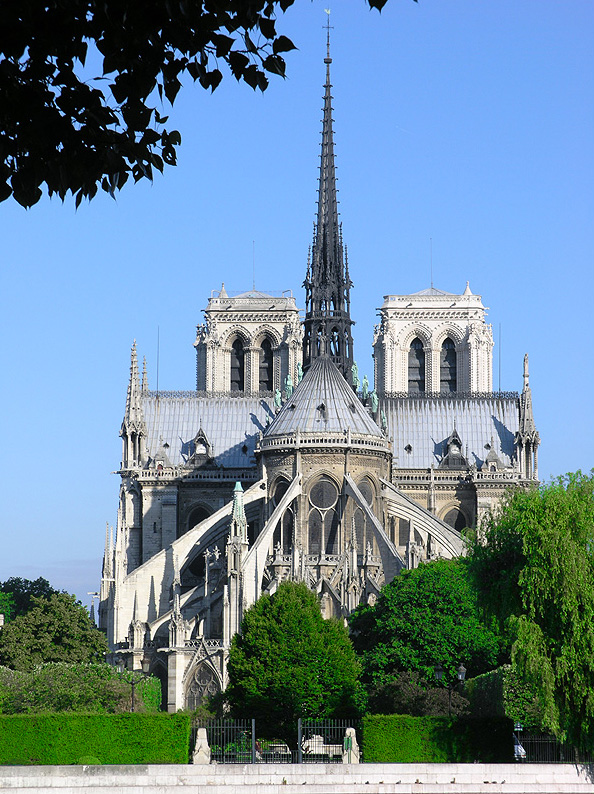Flèche (architecture) on:
[Wikipedia]
[Google]
[Amazon]

 A flèche (; ) is the name given to
A flèche (; ) is the name given to
 A flèche (; ) is the name given to
A flèche (; ) is the name given to spire
A spire is a tall, slender, pointed structure on top of a roof of a building or tower, especially at the summit of church steeples. A spire may have a square, circular, or polygonal plan, with a roughly conical or pyramidal shape. Spire ...
s in Gothic architecture
Gothic architecture is an architectural style that was prevalent in Europe from the late 12th to the 16th century, during the High Middle Ages, High and Late Middle Ages, surviving into the 17th and 18th centuries in some areas. It evolved f ...
. In French, the word is applied to any spire, but in English it has the technical meaning of a ''spirelet'' or ''spike'' on the rooftop of a building. In particular, the spirelets often were built atop the crossings of major churches in mediaeval French Gothic architecture
French Gothic architecture is an architectural style which emerged in France in 1140, and was dominant until the mid-16th century. The most notable examples are the great Gothic cathedrals of France, including Notre-Dame Cathedral, Reims Cathed ...
are called flèches.
On the ridge of the roof on top of the crossing (the intersection of the nave
The nave () is the central part of a church, stretching from the (normally western) main entrance or rear wall, to the transepts, or in a church without transepts, to the chancel. When a church contains side aisles, as in a basilica-type ...
and the transept
A transept (with two semitransepts) is a transverse part of any building, which lies across the main body of the building. In cruciform ("cross-shaped") cruciform plan, churches, in particular within the Romanesque architecture, Romanesque a ...
s) of a church, flèches were typically light, delicate, timber-framed constructions with a metallic sheath of lead or copper. They are often richly decorated with architectural and sculptural embellishments: tracery
Tracery is an architectural device by which windows (or screens, panels, and vaults) are divided into sections of various proportions by stone ''bars'' or ''ribs'' of moulding. Most commonly, it refers to the stonework elements that support th ...
, crocket
A crocket (or croquet) is a small, independent decorative element common in Gothic architecture. The name derives from the diminutive of the Old French ''croc'', meaning "hook", due to the resemblance of a crocket to a bishop's Shepherd's crook, ...
s, and miniature buttress
A buttress is an architectural structure built against or projecting from a wall which serves to support or reinforce the wall. Buttresses are fairly common on more ancient (typically Gothic) buildings, as a means of providing support to act ...
es serve to adorn the flèche.
Flèches are often very tall: the Gothic Revival
Gothic Revival (also referred to as Victorian Gothic or neo-Gothic) is an Architectural style, architectural movement that after a gradual build-up beginning in the second half of the 17th century became a widespread movement in the first half ...
spire of Notre-Dame de Paris
The Spire of Notre-Dame de Paris is located above the cross-section of the cathedral's transept. Notre-Dame de Paris has had three timber spires made of oak, known as flèches. The first was built between 1220 and 1230. It eventually became so d ...
(18582019) by Eugène Viollet-le-Duc
Eugène Emmanuel Viollet-le-Duc (; 27 January 181417 September 1879) was a French architect and author, famous for his restoration of the most prominent medieval landmarks in France. His major restoration projects included Notre-Dame de Paris, ...
was about before its destruction in the Notre-Dame de Paris fire
On 15 April 2019, at 18:18 CEST, a structural fire broke out in the roof space of Notre-Dame de Paris, a medieval Catholic cathedral in Paris, France.
The fire, which investigators believe was started by a cigarette or an electrical sh ...
, while the 16th century flèche of Amiens Cathedral
The Cathedral of Our Lady of Amiens (), or simply Amiens Cathedral, is a Catholic Church, Catholic cathedral. The cathedral is the seat of the Bishop of Amiens. It is situated on a slight ridge overlooking the River Somme in Amiens, the administra ...
is high.
The highest flèche in the world was built at the end of the 19th century for Rouen Cathedral
Rouen Cathedral () is a Catholic church architecture, church in Rouen, Normandy, France. It is the Episcopal see, see of the Archbishop of Rouen, Primate of Normandy. It is famous for its three towers, each in a different style. The cathedral, b ...
, high in total.
A short spire or flèche surrounded by a parapet
A parapet is a barrier that is an upward extension of a wall at the edge of a roof, terrace, balcony, walkway or other structure. The word comes ultimately from the Italian ''parapetto'' (''parare'' 'to cover/defend' and ''petto'' 'chest/brea ...
is common on churches in Hertfordshire
Hertfordshire ( or ; often abbreviated Herts) is a ceremonial county in the East of England and one of the home counties. It borders Bedfordshire to the north-west, Cambridgeshire to the north-east, Essex to the east, Greater London to the ...
; as a result, this type of flèche is called a Hertfordshire spike.
See also
*Flèche faîtière
A ''flèche faîtière'' is a French term that describes a carved rooftop spear, spire or finial that adorns houses of Melanesians in New Caledonia (the ''Kanak''), particularly those of their chiefs. The ceremonial carving is the home of ancestr ...
* Ridge turret
A ridge turret is a turret or small tower constructed over the ridge or apex between two or more sloping roofs of a building. It is usually built either as an architectural ornament for purely decorative purposes or else for the practical housing ...
Notes
Architectural elements Church architecture {{architecturalelement-stub